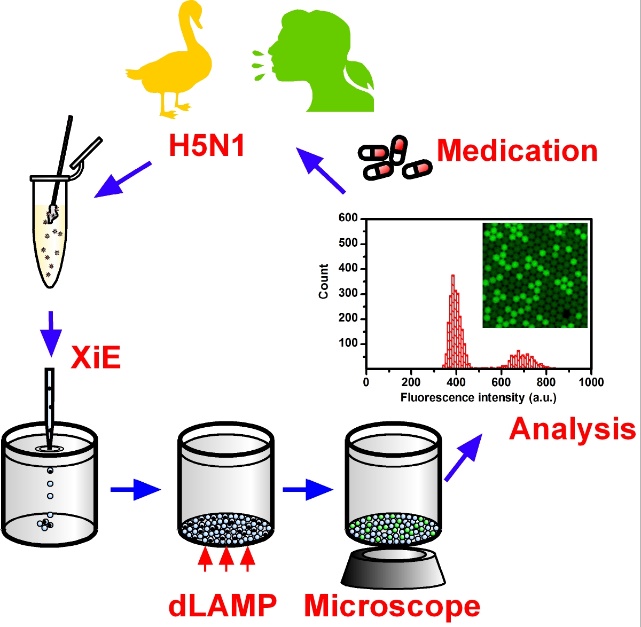Highly pathogenic avian influenza (HPAI) H5N1 viruses are deadly for wild birds and poultry, and have caused severe human diseases with fatal outcomes. Sporadic outbreaks of HPAI are not expected to diminish in the short term, posing a continuing threat to global public health.
Rapid, specific and quantitative detection of HPAI is especially important. Loop mediated isothermal amplification (LAMP) is an isothermal nucleic acid amplification technique, which has been validated as an advantageous alternative to conventional PCR-based assays. LAMP is especially suitable for rapid and point-of-care detection of viruses under resource-limited conditions.
Recently, digital LAMP (dLAMP) has been introduced, which measures absolute quantities by counting nucleic acids partitioned in a large number of microvolumes under isothermal conditions, without need of real-time fluorescence detection. dLAMP does not depend on the standard curve, and is ideal for quantitative detection of viral loads. Therefore, it is of great significance to develop simple and low cost dLAMP technologies for the absolute quantification of H5N1 viruses.
A research team led by Prof. DU Wenbin from the Institute of Microbiology, Chinese Academy of Sciences (IMCAS), has developed a method for the production of droplet arrays, called Cross-interface Emulsification (XiE) (Xu et al., 2016, Anal. Chem. 88:3171-3177). The principle is to vibrate the capillary, in high frequency, with stable flow of aqueous liquid at the oil-gas interface, rapidly producing uniform droplets with volumes of picoliter to nanoliter.
At the bottom of wells of a 96-well plates, the droplets assemble into a monolayer droplet arrays, which enables rapid fluorescence imaging. The XiE technology is independent of micro-fabrication, low cost, highly automated, and suitable for the digital nucleic acid amplification analysis, including digital PCR and digital LAMP.
Collaborating with Prof. HE Hongxuan’s lab in the Institute of Zoology, CAS, the XiE-based dLAMP method is established for rapid and quantitative detection of H5-subtype avian influenza viruses, and used for the analysis of model and real samples.
The dLAMP method is specific and highly sensitive with the detection limit of less than 10 copies, which is in accordance with qPCR and dPCR by QX200 (Bio-Rad). Notably, dLAMP is more tolerant of inhibitory substances such as humic acid and SDS than PCR-based methods, making it suitable for clinical or in-field collected samples that contain hard-to-remove inhibitors.
This project is supported by the National Key Research and Development Program, and has been published online on Analytical Chemistry. Dr. HU Yi, a postdoctoral fellow from HE’s lab and Dr. XU Peng from DU’s lab are the co-first authors of this article.
Link: http://pubs.acs.org/doi/abs/10.1021/acs.analchem.6b03328

Workflow: quantification of H5N1 viral loads using dLAMP by XiE(By Wenbin Du)
Key words: absolute quantification; avian influenza; digital LAMP
Contact:
Dr. DU Wenbin
State Key Laboratory of Microbial Resources ,Institute Of Microbiology,Chinese Academy of Sciences,100101,Beijing, China
E-mail: wenbin@im.ac.cn